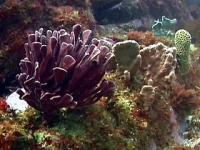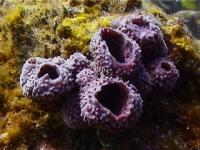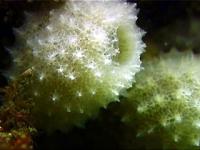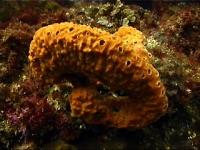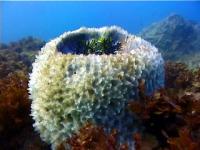Sponges: More Than Just a Bathroom Accessory
One animal that every diver will have encountered, because they don’t hide or swim away and are mostly brightly coloured: the sponge. Sponges are single or colonial animals which body bears many pores. Hence the name of its Phylum: Porifera (Latin porus, “pore”; ferre, “to bear”). This phylum contains the most primitive multicellular organisms known.
The sessile nature of sponges and their asymmetrical appearance convinced the earliest naturalists that they were plants. Unlike almost any of the other multicellular organisms, sponges lack a nervous system and have no true muscles. Sponges lack specialised reproductive, digestive, respiratory, sensory or excretory organs. They come in many shapes and sizes from small encrusting forms to large erect vases.
These filterfeeders are exclusively aquatic and can be found at all latitudes and from the intertidal zone to the deepsea. There are about 10,000 known species and 98% of them are marine.
Two unique organisational attributes define sponge and played a major role in the poriferan success. These two features are the water current channels and the highly totipotent nature of sponge cells (i.e., sponge cells retain a high degree of mobility and are capable of changing form and function). Sponges have a remarkable ability to regenerate: when cells of a sponge are mechanically separated, the cells will actively migrate and form a fully functional sponge within two to three weeks.
The body of a sponge is build up in three layers. The outer layer is formed by flattened cells that have the ability to contract (pinacocytes). The inner, non-living gelatinous layer contains amoeboid cells and cells that secrete spicules and fibers, which are used for structural support. The inner layer of sponges consists of flagellated cells (choanocytes) that circulate water through the sponge to bring in food as well as a means for waste removal.
Since sponges have a delicate water circulation system, sponges cannot tolerate environments with a high rate of sedimentation. Their pores are easily clogged and the animals have no defense against burial. Consequently we find sponges most often in areas where water is clean and the sedimentation rate low.
The volume of water passing through a sponge can be enormous, up to 20,000 times its volume in a single 24-hour period. In general sponges feed by filtering bacteria from the water that passes through them. They can trap up to 90% of all bacteria in the water they filter. Any sponges however harbour symbionts such as green algae, dinoflagellates, or cyanobacteria from which they also derive nutrients. One species is known to capture whole crustaceans. This species of the Abestopluma genus, lacks the pores and flagellated cells that most sponges use to filter water and is found in shallow sea caves in the Mediterranean Sea.
Sponges are distributed into 3 classes, based mostly upon the chemical composition and morphology of their supporting elements (spicules, fibers, spongin).
Members of the Class Calcarea bear spicules composed only of calcium carbonate. These sponges do not grow below 100 m since they need a firm substrate for attachment, unlike the other two classes, which are able to grow on soft sediments. Class Demospongiae, which contains about 95% of all sponge species, have support spicules and fibers that may be composed of silica and/or spongin, but never calcium carbonate. All freshwater sponges are found in this class. Their habitat is widespread and demosponges can be found at all depths. The final group, the Class Hexactinellida, contains sponges whose bodies are supported by six-rayed siliceous spicules; these are known as the “glass sponges” and are largely restricted to depths below 200 m, except in cold Antarctic environments.
It is widely accepted that the Calcarea and Demospongiae are more closely related to each other than either is to Hexactinellida.
All sponges appear to be capable of sexual reproduction, and several types of asexual processes are also common. Many of the details of these processes are unknown, however, largely because sponges lack distinct or localised gonads.
Most sponges are hermaphroditic, but they produce eggs and sperm at different times and cross-fertilise one another. Eggs and sperm unite to produce a free-swimming larva that settles on a new surface. Reproduction can also occur by small internal asexual buds called gemules, each one able to give rise to a new sponge.
Not much is know about the growth rates of sponges, but it is known that is varies greatly between different species. Some species only live for one year (especially Calcarea of colder waters); they grow from larvae to reproductive adulthood in a matter of months. Others are perennials and grow so slowly that almost no change can be seen from one year to the next. This counts for most of the tropical and polar demosponges. The age estimates of perennial species range from 20 to 100 years.
Only six different species of sponge are considered useful to make bath sponges. The skeleton of these sponges is composed only of spongin tissue and contains no hard spicules. The Mediterranean sponges are the softest and best; those of the Red Sea are next in quality and the West Indian species are coarser and less durable. Divers gather the sponges and the living tissue is allowed to decompose. The remaining undecomposed skeleton of spongin fibers is then washed, bleached, sometimes dyed and cut into the familiar blocks seen in shops.
Sponges have been harvested for millennia. The industry peaked in 1938, when the world’s annual sponge catch exceeded 2.6 million pounds (1200 tons). The majority of the commercial sponges belong to the genera Euspongia, Hippiospongia and Spongia.
Sponges are very common. Most grow on rocks or occasionally on sand/mud surfaces where they are exposed to potential predation. Many biologists suggests that biochemical defenses protect sponges from being cropped excessively by predators. Studies over the last two decades have revealed that sponges produce a suprisingly broadspectrum of biotoxins, some of which are quite potent. A few, such as those of Tedania and Neofibularia can cause painful skinrashes in humans. Not only are those chemicals used to deter predators they are also helpful to prevent infection by microbes and to compete for space with other sessile invertebrates such as ectoprocts, ascidians, corals and even other sponges. Compounds with respiratory, cardiovascular, gastrointestinal, anti-inflammatory, antitumour and antibiotic activity have been identified from many marine sponges.
Next time you see a sponge take your time to have a close look at them. Maybe even use a handheld magnifying glass to further inspect the pores.
References
- Invertebrates, Brusca & Brusca. Chapter 7.
- The Encyclopaedia of Underwater Life, Banister and Campbell. Pages 166 – 171.
- Reader’s Digest Book of the Great Barrier Reef. Pages 156 – 163
- Under Southern Seas. Neil Andrew. Chapter 16.


